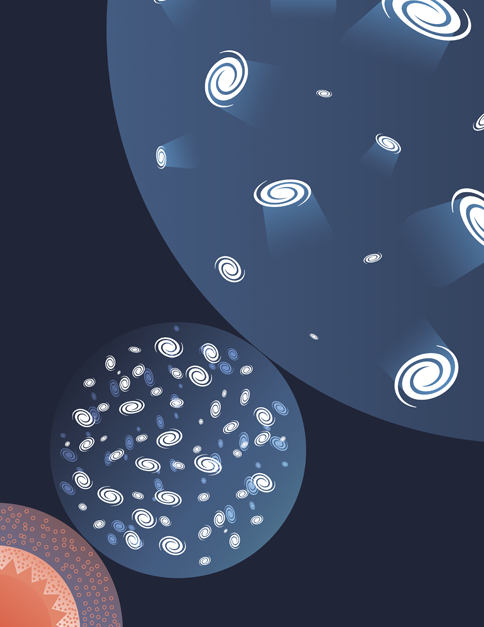Identify the new physics of dark matter
Astrophysical observations imply that the known particles of the Standard Model make up only about one-sixth of the total matter in the Universe. The rest is dark matter (DM). Dark matter is presumed to consist of one or more kinds of new particles. The properties of these particles, which are all around us, are unknown. Dark matter represents a bizarre shadow world of fundamental particles that are both omnipresent and largely imperceptible. Experiments are poised to reveal the identity of dark matter, a discovery that would transform the field of particle physics, advancing the understanding of the basic building blocks of the Universe.
There are many well-motivated ideas for what dark matter could be. These include weakly interacting massive particles (WIMPs), axions, and new kinds of neutrinos. It is imperative to search for dark matter along every feasible avenue. There are four known experimental approaches, each providing essential clues: direct detection, indirect detection, observation of large-scale astrophysical effects, and dark matter production with particle colliders. Direct detection experiments are sensitive to dark matter interactions with ordinary particles in the laboratory and will follow a progression from currently proposed second-generation (DM G2) experiments to much larger third-generation (DM G3) experiments. Indirect detection experiments, such as the Cherenkov Telescope Array (CTA) gamma-ray observatory, can spot the particle debris from interactions of relic dark matter particles in space. Cosmic surveys are sensitive to dark matter properties through their effects on the structures of galaxies. Experiments now at the LHC and eventually at future colliders seek to make dark matter particles in the laboratory for detailed studies.
Understand cosmic acceleration: dark energy and inflation
Armed with the dual tools of telescopes that peer back in time and high-energy accelerators that study elementary particles, scientists have pieced together a story of the origin and evolution of the Universe. An important part of this story is the existence of two periods during which the expansion of the Universe accelerated. A primordial epoch of acceleration, called inflation, occurred during the first fraction of a second of existence. The cause of this inflation is unknown but may have involved fundamentally new physics at ultra-high energies. A second distinct epoch of accelerated expansion began more recently and continues today. This expansion is presumed to be driven by some kind of dark energy, which could be related to Einstein’s cosmological constant, or driven by a different type of dark energy that evolves with time.
Resolving these mysteries requires better measurements of how rapidly the Universe was expanding during the past ten billion years. The Dark Energy Spectroscopic Instrument (DESI) can do this precisely enough to determine the properties of dark energy to the percent level over the course of billions of years. The matter in the Universe is gathered into patterns whose structure on large scales also carries information about the properties of dark energy. The Large Synoptic Survey Telescope (LSST), measuring the positions, shapes, and distances of billions of galaxies, will perform many separate tests of the properties of dark energy using the large-scale structure. Together, DESI and LSST can also probe the possibility that, instead of dark energy, new laws of space and time beyond those introduced by Einstein are responsible for the recent cosmic acceleration.
Understanding inflation is possible by measuring the characteristics of two sets of primordial ripples: those that grew into the galaxies observed today and gravitational waves, undulations in space and time that may have been observed just months ago by the BICEP2 telescope looking at the cosmic microwave background (CMB). Current CMB probes will lead to a Stage 4 Cosmic Microwave Background (CMB-S4) experiment, with the potential for important insights into the ultra-high energy physics that drove inflation.
Explore the unknown: new particles, interactions, and physical principles
There are clear indicators of new phenomena awaiting discovery beyond those motivating the other four Drivers. Particle physics is a discovery science defined by the search for new particles and new interactions, and by tests of physical principles. The tools for this search are varied and include very high-energy beams of protons and electrons, intense beams of protons, and cosmic sources of ultra high-energy particles. The searches take two basic forms: producing new particles and detecting the quantum influence of new particles.
Producing new particles: The path for discovery of new particles by producing them in the laboratory is through high-energy colliders like the LHC. Well-motivated extensions of the Standard Model, such as Low-energy Supersymmetry, predict that a number of such particles should be within reach of LHC. HL-LHC will extend the reach for new particles that could be missed by LHC, either because they are very heavy or because they are very difficult to detect. In the event that one or more new particles are discovered during LHC running, HL-LHC experiments will be essential to reveal the identities and underlying physics of these particles.
Detecting the quantum influence of new particles: The existence of new particles that are too heavy to be produced directly at high-energy colliders can be inferred by looking for quantum influences in lower energy phenomena. There are many examples of such experiments taking place in Europe, Japan, China, and the U.S. The global program includes projects that are complementary to one another using different kinds of particles as probes that are sensitive to different types of new particles and interactions. Some notable examples involve a revolutionary increase in sensitivity for the transition of a muon to an electron in the presence of a nucleus Mu2e (Fermilab) and COMET (J-PARC), further studies of rare processes involving heavy quarks or tau leptons at Belle II (KEK) and LHCb (LHC), and a search for proton decay using the large neutrino detectors of the LBNF and proposed Hyper-K experiments.
Future Opportunities: In the longer term, very high-energy e+e–colliders and very high-energy proton colliders could extend the search for new particles and interactions, as well as enable precision studies of the Higgs boson and top quark properties. Upgrades to the accelerator complex at Fermilab (PIP-II and additional improvements) will offer further opportunities to detect the influence of new particles in rare processes.
Enabling R&D
Advances in accelerators, instrumentation, and computing are necessary to enable the pursuit of the Drivers. Greater demands are being placed on the performance in all three areas, at reduced cost, necessitating continued investments in R&D. The DOE General Accelerator R&D (GARD) program and Accelerator R&D Stewardship program, as well as the new NSF Basic Accelerator Science program, form the critical basis for both long- and short-term accelerator R&D, enriching particle physics and other fields. Superconducting radio-frequency accelerating cavities, high-field superconducting magnets to bend and focus beams, advanced particle acceleration techniques, and other technologies are being developed for the required higher performance and lower cost of future accelerator concepts. Directed R&D programs, such as for the LHC Accelerator Research Program (LARP) and the Fermilab Proton Improvement Plan-II (PIP-II), will enable the next generation of accelerators. State-of-the-art test facilities at the national laboratories support activities on advanced accelerator R&D by both university and laboratory scientists. New particle detection techniques and instrumentation developments will provide the higher resolutions and higher sensitivities necessary to address the ever more challenging demands of future accelerator-based, underground, and cosmic particle physics experiments. Meanwhile, new computing and software techniques for acquiring, processing, and storing large data sets will empower future experiments to address not only more challenging questions, but also a broader sweep of questions.




